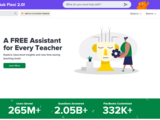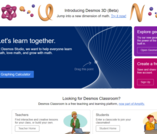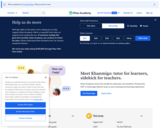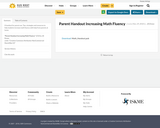
Build number sense and have fun!
- Subject:
- Math
- Material Type:
- Activity/Lab
- Author:
- Jill Staake
- Posted Jill Staake
- Date Added:
- 06/22/2020

Build number sense and have fun!

Improve number sense and have fun.

Build number sense...have fun!

CK-12 Foundation gives access to high quality educational materials for K-12 students all over the world.
They have high-quality, standards-aligned, open content in the STEM subjects.
This is an OUTSTANDING resource. Be sure to check out the Math & Science FlexLets
Students - select "switch to student version" from the top menu.

Learn More at mathantics.comVisit http://www.mathantics.com for more Free math videos and additional subscription based content!

Desmos now has way more than just a graphing calculator (which is pretty great too!).
You can now access student or teacher accounts for free and find interactive lessons for online and classroom learning for Grade 6-12+ Math.
Topics include linear equations, 3D models, quadratic equation, exponential functions, problem solving, real world application, linear functions, etc.
Engaging activities include pizza maker, marble mini golf, scaling machines & much more!
Once you're comfortable, you can even make your own activities!

ESTIMATION 180 is a place for both students and teachers to enjoy making sense of math and develop their number sense together. Pick from over 200 visual estimation tasks that invite all your students to be part of rich math conversations and learning.
Each task begins with a question where student must analyze the evidence in the photo to answer the question. It provides lots of success for students who have different levels of thinking, and allows them to succeed even without getting the correct answer.

Challenge first graders with math problems that will help them master first-grade math skills! In first grade, students learn about money, time, measurements, and patterns. Building a solid number sense is important for students in this age range. First graders learn to recognize patterns and sort objects by color, shape, and function. They will also learn to recognize and differentiate between two-dimensional and three-dimensional geometric shapes like squares, triangles, cones, and cylinders. By the end of first grade, students should be able to count to one hundred by ones, twos, fives, and tens. They will also be introduced to the concepts of more and less, and have an opportunity to work with simple graphs.
Now that your child has mastered numbers and counting, it's time to take things to the next level with our first-grade math worksheets! Keep students' math minds sharp with daily first-grade math and critical thinking practice worksheets as well as daily homework and practice pages. Weekly word problems, first-grade algebra and geometry, counting and comparing numbers, and introduction to addition are just some of the engaging, no-prep first-grade math worksheets available on this page.

Great activities sorted by grade - you can also sort them by subject by selecting that in the top left corner!
For Grades 3-12 & ungraduate.

"Free Printable Math Worksheet Sampler Packs - Need a quick resource for your students to practice their math skills? The sampler packs below are available for free with no login required!"
Grades K-9 + Algebra & Geometry.
Jumbo Math Worksheets Pack

Watch. Practice. Learn almost anything for free.
Now with ELA!
*Math K-12 (including "get ready for grade X to prepare") + college level
*Computing
*Science
*Arts, Business & Humanities
*Reading & ELA
*Life Skills - growth mindset, AI, financial literacy, SEL, safety, career
*Economics

Challenge your kindergarteners to math worksheets that will inspire them to learn to be creative as they count by 5s, 10s, learn numbers to 100, and start to add and subtract small numbers. Lots of handwriting number practice and fun math problems to solve in these kindergarten math worksheets.
The resources include: weekly math review booklets, Kindergarten Math Minutes, math worksheets, monthly math challenge booklets, addition, math enrichment, hundreds charts, math facts, number sense, patterns, place value, subtraction, mental math, geometry, ordering, counting, number lines, calendar skills, comparing numbers, color by number, color by addition, color by subtraction, skip counting, number mazes, shape mazes, matching, grids, greater than/less than, and hundreds chart.

This site includes apps, games, learning tools and other additional supports for math at school and at home.
Many virtual manipulatives are available including Canadian Money!

A handout for parent use. Tips, strategies and resources to help students increase math fluency with help from parents at home.

A Provincial Resource for Teachers and Leaders of Mathematics in Saskatchewan.
CONTENTS
Establishing a Mathematically Rich and Safe Environment
This section contains the following subsections:
Learning and Classroom Environment
Nurturing Positive Relationships
Physical Environment
Fostering a Mathematically Rich Classroom
Math Tools and Resources
Math Manipulatives
Indigenous Ways of Knowing Connection to Establishing a Rich and Safe Environment
Supporting Families; and
Supporting Indigenous Families
Honouring Indigenous Ways of Knowing
Cultural Affirmation and School Climate
Shared Decision-Making
Curriculum Actualization
Lifelong Learning
Elder Protocol
Tobacco Offering
Theresa’s Story: Benefits of Interacting with Elders and Knowledge Keepers
Practising Holistic Assessment
This section contains the following subsections:
Assessment OF, AS, and FOR Learning
Using the Triangulation of Data
Spaced Practice
Education Sector Strategic Plan (ESSP) Math Data Collection
Math Screeners
Indigenous Ways of Knowing Connection to Practising Holistic Assessment
Culturally Valid Assessment
Responding with Effective Instructional Practices
This section contains the following subsections:
Curriculum Connections
Learning Stages and Scope Sequence
Instructional Approaches
Pedagogical Models in a Mathematics Context
Mathematicians Workshop
Vocabulary and the Language of Math
Differentiation and Responsive Pedagogy;
Intervention
Tiered Intervention in Math
The Role of Technology; and
Indigenous Ways of Knowing Connection to Responding with Effective Instructional Practices
Developing Number Sense
Instructional Approaches in Number Sense, (along with resources and support for elementary, middle and high school mathematics); including
Comparing
Composing and Decomposing
Estimating
Visualizing
Representing
Other Instructional Approaches
Indigenous Ways of Knowing Connection to Developing Number Sense.
Integrating Relevant Research
This section contains the following subsections:
Works Cited
Bibliography
Additional research for your consideration

The main areas of focus in the second grade math curriculum are: understanding the base-ten system within 1,000, including place value and skip-counting in fives, tens, and hundreds; developing fluency with addition and subtraction, including solving word problems; regrouping in addition and subtraction; describing and analyzing shapes; using and understanding standard units of measure; working with money and time; and introducing multiplication.
The worksheets and printables for second grade math available on this page will enhance any classroom's math curriculum. These engaging second grade math worksheets cover the basics of counting and ordering as well as addition and subtraction, and include exciting introductions to geometry and algebra for future self-assurance in math.

This is a website full of resources for PowerPoint and projector and students to see math visually through games.

Third-grade math instruction is focused on the following areas: developing an understanding of multiplication and division and strategies for multiplication and division within 100; developing an understanding of fractions, especially unit fractions (fractions with numerator 1); developing an understanding of the structure of rectangular arrays and of area; describing and analyzing two-dimensional shapes.
The best way to ensure your students fully grasp the math concepts they'll need to successfully progress in their education is to practice as much as possible. The worksheets, puzzles, games, and other resources available here are the perfect solution for parents and teachers who want to provide their third graders with the tools they need to understand and excel in third-grade math.

Jen Saul combines think time, partner discussions, and an emphasis on students' personal strategies to build confidence through mental math. Students use and discuss the strategies of "decomposing," "splitting," and "jumps of ten."

Lamarr Oksasikewiyin provides traditional games for developing number sense with early learners. Lamarr created a series of Facebook videos with a focus on number games, number concepts, and traditional ways of knowing. A Facebook account is not required to view.